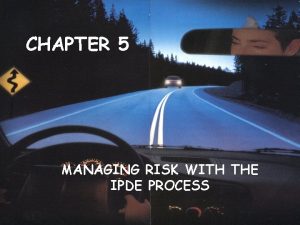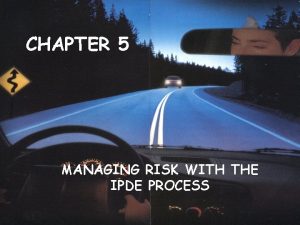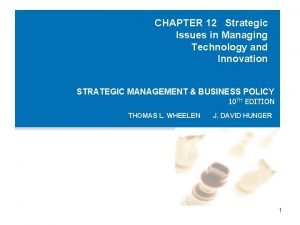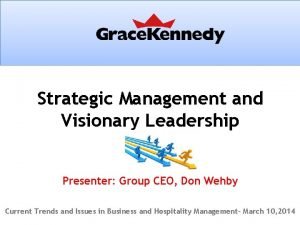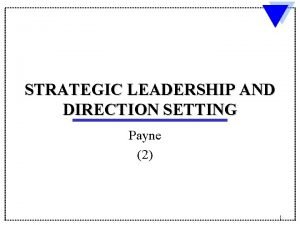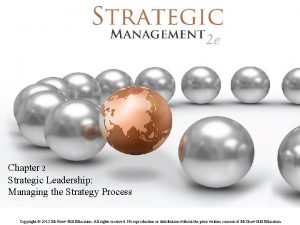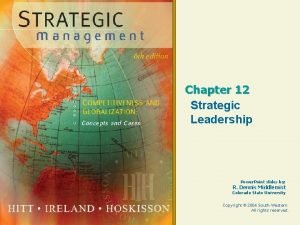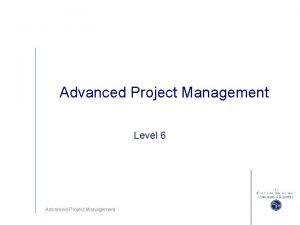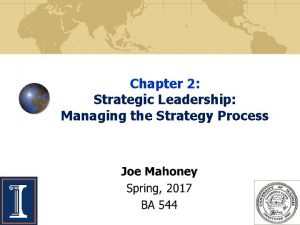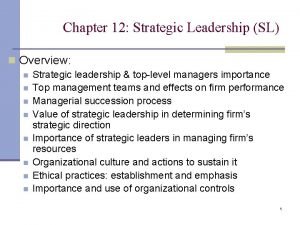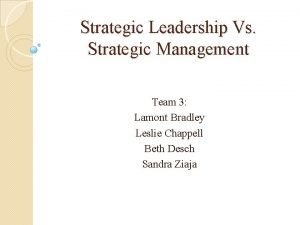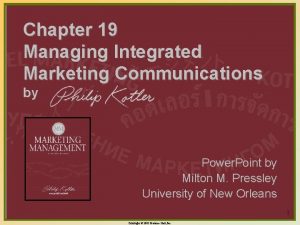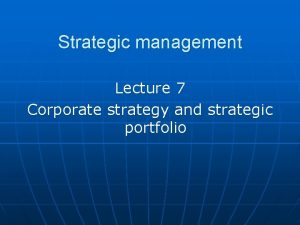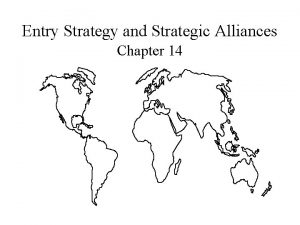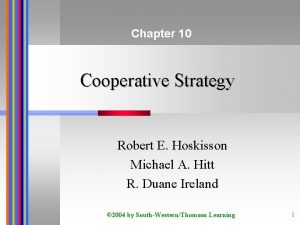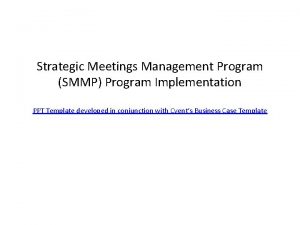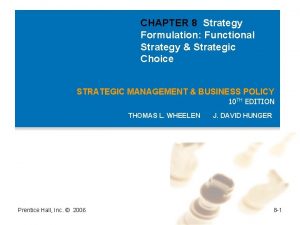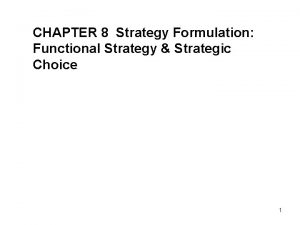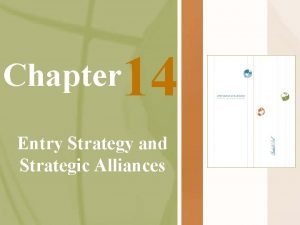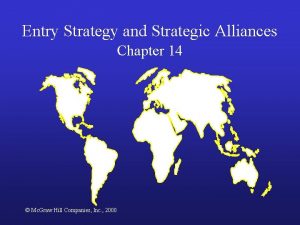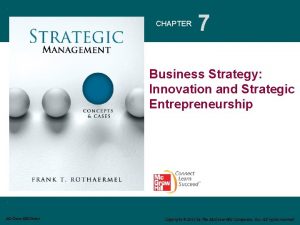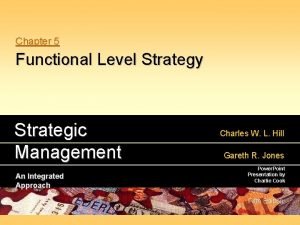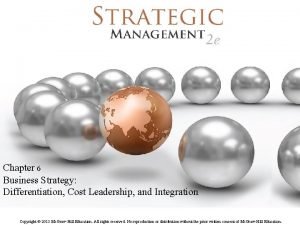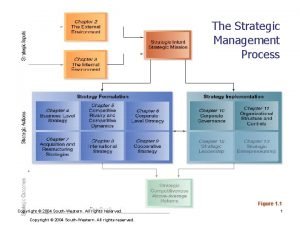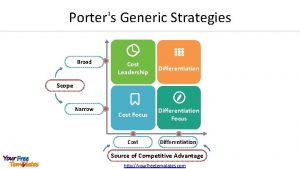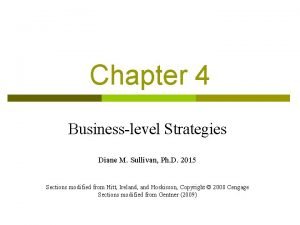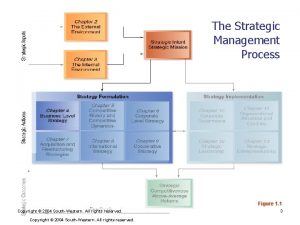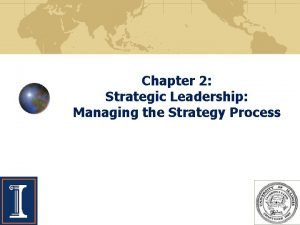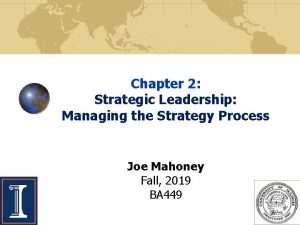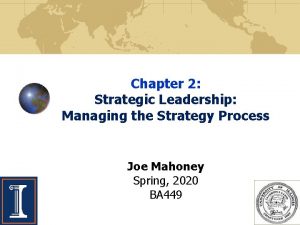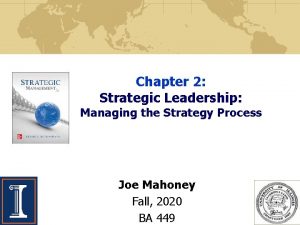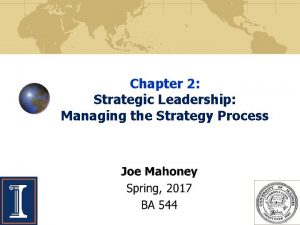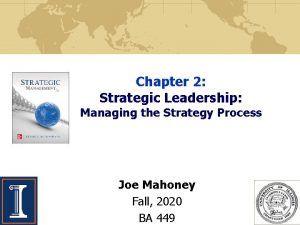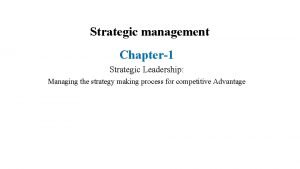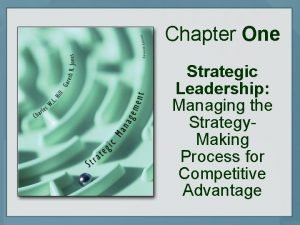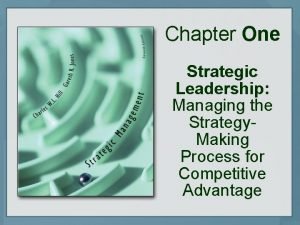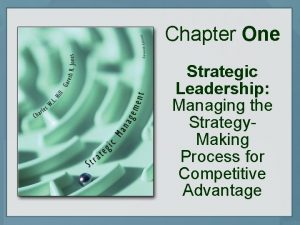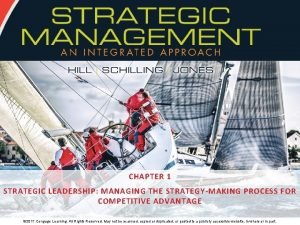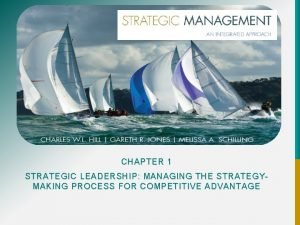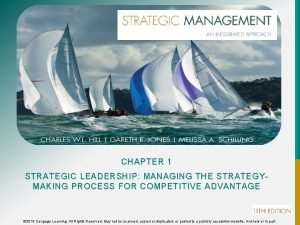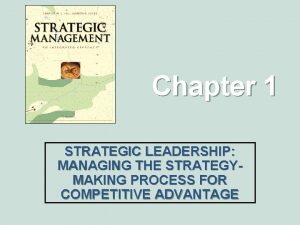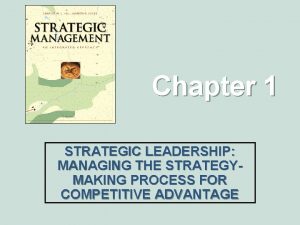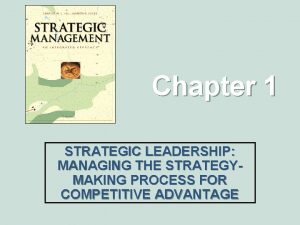Chapter 2 Strategic Leadership Managing the Strategy Process
















































































- Slides: 80

Chapter 2 Strategic Leadership: Managing the Strategy Process

The AFI Strategy Framework Jump to Appendix 1 long image description ©Mc. Graw-Hill Education.

Chapter 2 Outline 2. 1 Vision, Mission, and Values – Vision – Mission – Values 2. 2 Strategic Leadership – What Do Strategic Leaders Do? – How Do You Become an Effective and Ethical Strategic Leader? – Formulating Strategy across Levels 2. 3 The Strategic Management Process – Top-Down Strategic Planning – Scenario Planning – Strategy as Planned Emergence 2. 4 Implications for the Strategist ©Mc. Graw-Hill Education.

Learning Objectives LO 2 -1 Describe the roles of vision, mission, and values in the strategic management process. LO 2 -2 Evaluate the strategic implications of productoriented and customer-oriented vision statements. LO 2 -3 Explain why anchoring a firm in ethical core values is essential for long-term success. LO 2 -4 Outline how managers become strategic leaders. LO 2 -5 Describe the roles of corporate, business, and functional managers in strategy formulation and implementation. LO 2 -6 Evaluate top-down strategic planning, scenario planning, and strategy as planned emergence. ©Mc. Graw-Hill Education.

Vision, Mission, and Values ©Mc. Graw-Hill Education.

Key Definitions • Strategic Management Process – Put in place by leaders – Helps formulate and implement strategy – Foundational for sustainable competitive advantage • Strategic Leadership – Use of power and influence – Direct the activities of others – Pursue organizational goals ©Mc. Graw-Hill Education.

Vision, Mission, and Values • Vision: – What do we want to accomplish? • Mission: – How do we accomplish our goals? • Values: – What commitments do we make? – What guardrails do we put in place? – How can we act legally and ethically in pursuit of the vision and mission? ©Mc. Graw-Hill Education.

Key Aspects of an Effective Vision 1. Captures an organization’s aspiration 2. Identifies what it ultimately wants to accomplish 3. Motivates employees to aim for a target 4. Leaves room for contributions ©Mc. Graw-Hill Education.

Why Is a Vision Important? • Employees tend to feel part of something bigger than themselves. • Helps employees find meaning in their work • Allows employees to experience a greater sense of purpose ©Mc. Graw-Hill Education.

Teach for America’s Vision “One day, all children in this nation will have the opportunity to attain an excellent education. ” • This vision is: – Effective – Clear – Identifies what they ultimately want to accomplish – An inspiring target ©Mc. Graw-Hill Education.

Nordstrom’s Vision “To provide outstanding service every day, one customer at a time” ©Mc. Graw-Hill Education.

Mission Statements • Describe what an organization does – The products and services it provides – The markets in which it competes • Strategic Commitments: – Actions to achieve the mission that are: • Costly • Long-term oriented • Difficult to reverse. ©Mc. Graw-Hill Education.

Mission Statements Differ from Vision Statements • Vision statements: what an organization wants to accomplish – Teach for America’s vision: “to attain an excellent education for all children” • Mission statements: how the vision will be accomplished – TFA says it will achieve its vision by “enlisting our nation’s most promising future leaders in the effort” ©Mc. Graw-Hill Education.

Values • Principles to guide behavior • Employees at all levels can use them • Helps deal with complexity and conflict • Provides employees with a moral compass ©Mc. Graw-Hill Education.

Core Values Statements • Guide an organization to achieve its vision and fulfill its mission • Applies to internal conduct and external interaction • Can include ethical considerations ©Mc. Graw-Hill Education.

Product-Oriented Vision Statements • Defines a business in terms of a good or service provided • Example: “We are in the typewriter business” – Less flexible – Is not needs-based – Can lead to a myopic view • Railroads: – Saw themselves in the railroad business – Cars & jets: redefined long-distance transportation – Rail companies slow to respond ©Mc. Graw-Hill Education.

Customer-Oriented Vision Statements • Defines a business in terms of providing solutions to customer needs • Examples: – Google: “To organize the world’s information and make it universally accessible and useful. ” – Nike: “To bring inspiration and innovation to every athlete in the world. ” – Yahoo: “To make the world’s daily habits more inspiring and entertaining. ” ©Mc. Graw-Hill Education.

Visions Can Help Create Competitive Advantage • Vision statements and firm performance can be positively associated if: – The vision is customer-oriented – Internal stakeholders help define the vision – Organizational structures align with the vision statement ©Mc. Graw-Hill Education.

Organizational Core Values “How do we accomplish our goals? ” • Ethical standards and norms • Govern the behavior of individuals • Have two important functions: – Form the groundwork for long-term success – Help keep the company on track ©Mc. Graw-Hill Education.

Strategy Highlight 2. 1 (1 of 2) • Merck – Vision: “to preserve and improve human life” – Values: “We try to never forget that medicine is for the people. It is not for profits. The profits follow, and if we have remembered that, they have never failed to appear. ” • Merck’s donations helped eradicate river blindness ©Mc. Graw-Hill Education.

Strategy Highlight 2. 1 (2 of 2) • Vioxx – Painkiller, claimed fewer side effects than aspirin – Received allegations of more dangerous side effects • Merck’s reputation was damaged – Stock fell 30% – $27 billion in market value was lost – Lawsuits cost the company $30 billion ©Mc. Graw-Hill Education.

Strategic Leadership ©Mc. Graw-Hill Education.

What Is Strategic Leadership? • Successful use of power and influence • Directing the activities of others • Pursuing an organization’s goals • Enabling organizational competitive advantage ©Mc. Graw-Hill Education.

The Effect of Strategic Leaders Varies Leaders who have revitalized the business: • Tim Cook (Apple) • Cheryl Sandberg (Facebook) • Charles Prince (Citigroup) • Richard Wagoner (GM) • Marissa Mayer (Yahoo) • Robert Nardelli (Home Depot) • Mary Barra (GM) • Ron Johnson (JC Penney) ©Mc. Graw-Hill Education. Leaders who destroyed shareholder value:

Exhibit 2. 3: How CEOs Spend Their Days SOURCE: Data from O. Bandiera, A. Prat, and R. Sadun (2012), “Management capital at the top: evidence from the time use of CEOs, ” London School of Economics and Harvard Business School Working Paper. ©Mc. Graw-Hill Education.

Upper Echelon’s Theory • Organizational outcomes reflect the values of the top management team. – Outcomes include strategic choices & performance levels. • Leadership actions reflect: – Age, education, and career experiences – Personal interpretations of situations • Strong leadership: innate abilities and learning ©Mc. Graw-Hill Education.

Exhibit 2. 4 Level-5 Pyramid Jump to Appendix 2 long image description ©Mc. Graw-Hill Education. (Adapted to compare corporations and entrepreneurs) SOURCE: Adapted from J. Collins (2001), Good to Great: Why Some Companies Make the Leap. . . And Others Don’t (New York: Harper. Collins), 20.

Formulating Strategy • Strategy Formulation: where & how to compete • Strategy Implementation: how work gets done • Corporate Strategy – Industry, markets, and geography • Business Strategy – Cost leadership, differentiation, or integration • Functional Strategy – how to implement a chosen business strategy ©Mc. Graw-Hill Education.

Exhibit 2. 5 Strategy Formulation and Implementation Across Levels Jump to Appendix 3 long image description ©Mc. Graw-Hill Education.

Strategic Business Units (SBUs) • Standalone divisions of a larger conglomerate • Has profit-and-loss responsibility • Receive guidelines from corporate headquarters • Implement business strategy • Example: – Rosalind Brewer, CEO of Sam’s Club • Reports to Walmart’s CEO, C. Douglas Mc. Millon • Pursues a different strategy than Walmart • Offers higher-quality products and brand names ©Mc. Graw-Hill Education.

Functions Within Each SBU • Accounting, finance, human resources, product development, operations, manufacturing, marketing, and customer service • Functional managers responsible for – Decisions and actions in a single function – Contributing to business-level strategy ©Mc. Graw-Hill Education.

The Strategic Management Process ©Mc. Graw-Hill Education.

Three Approaches to Strategize for Competitive Advantage • Strategic planning – A formal, top-down planning approach • Scenario planning – A formal, top-down planning approach • Strategy as planned emergence – Begins with a strategic plan, less formal ©Mc. Graw-Hill Education.

Top Down Strategic Planning • Rational, data-driven strategy process • Top management attempts to program future success through – Detailed analysis of: • • • Prices Costs Margins Market demand Head count Production runs – Five year plans and correlated budgets – Performance monitoring ©Mc. Graw-Hill Education.

Exhibit 2. 6 AFI Framework for Top-Down Strategic Planning Jump to Appendix 4 long image description ©Mc. Graw-Hill Education.

Shortcomings of the Top-Down Approach • May not adapt well to change • Formulation separate from implementation • Information flows top-down (one-way) • The leaders’ future vision can be wrong • Example: Apple – Steve Jobs predicted customers needs ©Mc. Graw-Hill Education.

Scenario Planning • Uses a top-down approach • Asks “what if” questions – Top management envisions different scenarios. – Then they derive strategic responses. • Consider optimistic and pessimistic futures • Examples: – – ©Mc. Graw-Hill Education. New laws restrict carbon emissions Demographic shifts Changing economic conditions Technological advances

Exhibit 2. 7 AFI Framework for Scenario Planning Jump to Appendix 5 long image description ©Mc. Graw-Hill Education.

Formulation & Implementation Using Scenario Planning • Formulation Stage – Identify strategic options. – Develop contingency plans. – Use analytical tools. – Build future options. • Implementation Stage – Execute dominant strategic plan. • The option that best matches the current reality • Modifications made as needed – Determine if alternate scenario should be used ©Mc. Graw-Hill Education.

Strategy as Planned Emergence • Top Down and Bottom Up – Bottom-up strategic initiatives emerge – Evaluated & coordinated by management • Relies on data, plus: – Personal experience – Deep domain expertise – Front line employee insights ©Mc. Graw-Hill Education.

Example: Online Retailing • Some companies flourish: – Amazon and e. Bay • Others forced to adjust: – Best Buy, Home Depot, JCPenney • Others are out of business: – Circuit City and Radio Shack ©Mc. Graw-Hill Education.

Key Points About Strategy • Intended strategy – The outcome of a rational and structured top-down strategic plan • Realized strategy – Combination of intended and emergent strategy • Emergent strategy – Any unplanned strategic initiative – Bubbles up from the bottom of the organization – Can influence and shape a firm’s overall strategy ©Mc. Graw-Hill Education.

Strategic Initiatives • Any activity a firm pursues to explore and develop – New products and processes – New markets – New ventures • Can bubble up from deep within a firm through: – Autonomous actions – Serendipity – Resource-allocation process (RAP) ©Mc. Graw-Hill Education.

Autonomous Actions, Serendipity, and the Resource Allocation Process (RAP) • Autonomous actions – Strategic initiatives undertaken by employees – In response to unexpected external or internal opportunities • Serendipity – Random events, surprises, coincidences – Has an effect on strategic initiatives • Resource-allocation process (RAP) – How a firm allocates resources based on policy – Helps shape realized strategy ©Mc. Graw-Hill Education.

Strategy Highlight 2. 2 (1 of 2) • Diana – Starbucks manager in California – Received requests for iced beverage – Tried the beverage, and liked it • Requested Starbucks HQ offer the drink – Request denied – She did it anyway ©Mc. Graw-Hill Education.

Strategy Highlight 2. 2 (2 of 2) • Sales skyrocketed – Was eventually adopted by Starbucks Execs • This is now the Starbucks Frappuccino – At one point, was 20% of Starbucks revenues ©Mc. Graw-Hill Education.

Implications for the Strategist ©Mc. Graw-Hill Education.

Two Foundational Ingredients for Competitive Advantage 1. Inspiring vision & mission statements – Backed by ethical values – Customer-oriented / problem-defining • Correlated with success Allow for strategic flexibility to change – • To meet changing customer needs • To exploit external opportunities 2. An effective strategic management process ©Mc. Graw-Hill Education.

The 3 Strategy Processes Have Strengths & Weaknesses • Effectiveness dependent on rate of change – Slow / stable firm = choose top-down • Effectiveness dependent on firm size – Large firm = choose top-down or scenario planning • Examples: – Nuclear power provider • Top-down • Prep for black swan events through scenario planning – Fast moving companies: strategy as planned emergence • Google or Facebook ©Mc. Graw-Hill Education.

All Employees Should be Involved In Mission / Vision Statement Creation • Belief in the vision and mission is motivating. • Every employee plays a strategic role. • Any employee can have great ideas. • Exhibit 2. 9 compares and contrasts: – Top-down strategic planning – Scenario planning – Strategy as planned emergence ©Mc. Graw-Hill Education.

Chapter 2 Summary ©Mc. Graw-Hill Education.

Take Away Concepts (1 of 6) LO 2 -1 Describe the roles of vision, mission, and values in the strategic management process. • A vision captures an organization’s aspirations. An effective vision inspires and motivates members of the organization. • A mission statement describes what an organization actually does—what its business is—and why and how it does it. • Core values define the ethical standards and norms that should govern the behavior of individuals within the firm. ©Mc. Graw-Hill Education.

Take Away Concepts (2 of 6) LO 2 -2 Evaluate the strategic implications of product-oriented and customer-oriented vision statements. • Product-oriented vision statements define a business in terms of a good or service provided. • Customer-oriented vision statements define business in terms of providing solutions to customer needs. • Customer-oriented vision statements provide managers with more strategic flexibility than product-oriented missions. • To be effective, visions and missions need to be backed up by hard-toreverse strategic commitments and tied to economic fundamentals. ©Mc. Graw-Hill Education.

Take Away Concepts (3 of 6) LO 2 -3 Explain why anchoring a firm in ethical core values is essential for long-term success. • Ethical core values form a solid foundation on which a firm can build its vision and mission, and thus lay the groundwork for long-term success. • Ethical core values are the guardrails that help keep the company on track when pursuing its mission and its quest for competitive advantage. ©Mc. Graw-Hill Education.

Take Away Concepts (4 of 6) LO 2 -4 Outline how managers become strategic leaders. • To become an effective strategic leader, a manager needs to develop skills to move sequentially through five different leadership levels: highly capable individual, contributing team member, competent manager, effective leader, and executive. • The Level-5 strategic leadership pyramid applies to both, distinct corporate positions and personal growth. ©Mc. Graw-Hill Education.

Take Away Concepts (5 of 6) LO 2 -5 Describe the roles of corporate, business, and functional managers in strategy formulation and implementation. • Corporate executives must provide answers to the question of where to compete, whether in industries, markets, or geographies, and how to create synergies among different business units. • General managers in strategic business units must answer the strategic question of how to compete in order to achieve superior performance. They must manage and align the firm’s different functional areas for competitive advantage. • Functional managers are responsible for implementing business strategy within a single functional area. ©Mc. Graw-Hill Education.

Take Away Concepts (6 of 6) LO 2 -6 Evaluate top-down strategic planning, scenario planning, and strategy as planned emergence. • Top-down strategic planning is a sequential, linear process that works reasonably well when the environment does not change much. • In scenario planning, managers envision what-if scenarios and prepare contingency plans that can be called upon when necessary. • Strategic initiatives can be the result of top-down planning or can emerge through a bottom-up process from deep within the organization. They have the potential to shape a firm’s strategy. • A firm’s realized strategy is generally a combination of its top-down intended strategy and bottom-up emergent strategy, resulting in planned emergence. ©Mc. Graw-Hill Education.

Key Terms Autonomous actions Scenario planning Core values statement Serendipity Dominant strategic plan Strategic business unit (SBU) Emergent strategy Strategic commitments Illusion of control Strategy formulation Intended strategy Strategy implementation Level-5 leadership pyramid Strategic initiative Mission Strategic leadership Strategic management process Organizational core values Planned emergence Realized strategy Resource-allocation process (RAP) ©Mc. Graw-Hill Education. Top-down strategic planning Upper-echelons theory Vision

Chapter 2 Cases & Exercises ©Mc. Graw-Hill Education.

Chapter Case 2: Consider This… (1 of 3) • Yahoo: once a leader in online advertising • When the Internet was hard to use, Yahoo: – Provided a web portal – Was a “one stop shop” for mail, finance, sports – Was attractive for online advertisers • But…mobile devices came along… – Yahoo outpaced by Google, Facebook, and Twitter ©Mc. Graw-Hill Education.

Chapter Case 2: Consider This… (2 of 3) • Investors still don’t see much value. • Some say the true valuation is zero. • Yahoo financial results continue to decline. ©Mc. Graw-Hill Education.

Chapter Case 2: Consider This… (3 of 3) • How useful are the new vision and mission in Yahoo’s turnaround attempt? • How has Mayer turned Yahoo around? • What “grade” would you give Mayer? – What are her strengths and her weaknesses? – What level is she on the pyramid? • Are you skeptical of Yahoo’s future? ©Mc. Graw-Hill Education.

My Strategy Exercise: How Much Are Your Values Worth? 1. Identify your personal values. – How do these affect your career choice? 2. How much less salary would you accept? – To work for company aligned with your values? 3. How much are you willing to “pay for pay”? ©Mc. Graw-Hill Education.

Small Group Exercise #1 • STEM disciplines contribute to U. S. Competitiveness. – Limited supply of STEM professionals – STEM disciplines help address global issues • Group questions – How to ensure STEM education is a national policy priority? – How does STEM funding affect business major employment? – How can businesses help address global issues? – What skills are needed to manage STEM employees? ©Mc. Graw-Hill Education.

Small Group Exercise #2 • Some companies use 2% of their budgets to invest in new ideas. – Ideas can develop before further investment. • Managers can pool money for larger projects. • What problems need to be addressed? ©Mc. Graw-Hill Education.

End of Chapter 2

Strategy Smart Videos ©Mc. Graw-Hill Education.

Strategy Smart Videos (1 of 5) • Pepsi. Co Chairman and CEO Indra Nooyi • Pepsi. Co’s Performance with Purpose Overview • Link: – http: //www. pepsico. com/purpose • 2: 41 Minutes ©Mc. Graw-Hill Education.

Strategy Smart Videos (2 of 5) • Teach for America (TFA) • This is the story / background on TFA • Link: – https: //www. youtube. com/watch? v=9 J 7 wq. VJCFYw&featu re=c 4 -overviewvl&list=PLu 9 bhg. Te 3 LY 35_y. YOg. GW 3 k. Sy. IMdi. Lmcu. H • 5: 56 Minutes ©Mc. Graw-Hill Education.

Strategy Smart Videos (3 of 5) • Hilton Worldwide • Vision, Mission, Values • Link: – https: //www. youtube. com/watch? v=LKg. Gdnz 0658 • 2: 26 Minutes ©Mc. Graw-Hill Education.

Strategy Smart Videos (4 of 5) • Jim Collins • From Good to Great: What Defines a Level V Leader? • Link: – https: //www. youtube. com/watch? v=q-Ky. Q 90 XBy. Y • 2: 34 Minutes ©Mc. Graw-Hill Education.

Strategy Smart Videos (5 of 5) • Marissa Mayer • What's Next for Yahoo in Two Minutes • Link: – https: //www. youtube. com/watch? v=h 3 Pq. YDue. Bm 8 • 2: 08 minutes ©Mc. Graw-Hill Education.

Chapter Case 2 ©Mc. Graw-Hill Education.

Chapter Case 2: Yahoo (1 of 2) • Marissa Mayer’s job as CEO: turn it around – Yahoo was once the go-to Internet leader. • Web portal: e-mail, finance, sports, social media, and video – Stock went from $120 per share to as low as $5. – Mayer is the 5 th CEO in 3 years • Marissa Mayer: before Yahoo. – Grew up in Wisconsin, went to Stanford – Began career in Silicon Valley • Google’s 20 th hire and first female engineer • Helped develop Gmail, images, news, maps – Deeply involved in Google’s success ©Mc. Graw-Hill Education.

Chapter Case 2: Yahoo (2 of 2) • Mayer’s first acts at Yahoo: Culture – Re-tooled the vision / mission statements – Withdrew the option to work remotely – Installed weekly town-hall meetings • Mayer’s first acts at Yahoo: Cash – Sold Yahoo’s stake in Alibaba, a Chinese company – Spent $2 billion acquiring tech ventures • Filled in product line gaps • Brought in new engineering talent • Result: share price has tripled ©Mc. Graw-Hill Education.

Appendix 1 The AFI Strategy Framework The important inside circle is titled "Gaining and Sustaining a Competitive Advantage" that is at the very center of the image, with five different circles on on the outside of it. Arrows go back and forth from the center circle to each of the five outer circles. The five outer circles are labeled: (1) Getting Started, (2) External and Internal Analysis, (3) Formulation: Business Strategy, (4) Formulation, Corporate Strategy, and (5) Implementation. Each of these outer five circles have a brief description beside them to explain what the circle means: Under the first outer circle titled "Getting Started", it says: Part 1, Strategy Analysis, "What is Strategy (Chapter 1)" and "Strategic Leadership: Managing the Strategy Process (Chapter 2)". Under the second outer circle titled "External and Internal Analysis", it says: Part 1, Strategy Analysis, "External Analysis: Industry Structure, Competitive Forces and Strategic Groups (Chapter 3)", "Internal Analysis: Resources, Capabilities and Core Competencies (Chapter 4)", and "Competitive Advantage, Firm Performance, and Business Models (Chapter 5)". Under the third outer circle titled "Formulation: Business Strategy", it says: Part 2, Strategy Formulation, "Business Strategy: Differentiation, Cost Leadership and Integration (Chapter 6)" and "Business Strategy, Innovation and Entrepreneurship (Chapter 7)". Under the fourth outer circle titled "Formulation: Corporate Strategy", it says: Part 2, Strategy Formulation, "Corporate Strategy: Vertical Integration and Diversification (Chapter 8)", "Corporate Strategy: Strategic Alliances, Mergers and Acquisitions (Chapter 9)", and "Global Strategy: Competing Around the World (Chapter 10)". Under the fifth outer circle titled "Implementation", it says: Part 3, Strategy Implementation, "Organizational Design: Structure, Culture and Control (Chapter 11)", and "Corporate Governance and Business Ethics (Chapter 12)". Return to slide ©Mc. Graw-Hill Education.

Appendix 2 Exhibit 2. 4 Level-5 Pyramid This image shows a pyramid that progresses from Level 1 at the lowest part of the pyramid to Level 5 at the highest part of the pyramid. The levels as they progress are Level 1: Highly Capable Individual Level 2: Contributing Team Member Level 3: Competent Manager Level 4: Effective Leader Level 5: Executive Return to slide ©Mc. Graw-Hill Education.

Appendix 3 Exhibit 2. 5 Strategy Formulation and Implementation Across Levels This image shows several boxes in an organization-chart format. At the top level, is "Headquarters Corporate Strategy: Where to Compete? ", below that box are three different boxes, Strategic Business Unit (SBU) 1, SBU 2, and SBU 3, each of which say "Business Strategy, How to Compete? ". Under SBU 3 are four boxes, labeled Business Function 1, Business Function 2, Business Function 3, and Business Function 4. Each of these four boxes say "Functional Strategy: How to Implement Business Strategy? " Return to slide ©Mc. Graw-Hill Education.

Appendix 4 Exhibit 2. 6 AFI Framework for Top-Down Strategic Planning This image depicts three boxes. The top box is titled "Analysis" and contains three bullets titled Vision, Mission, and Values, External Analysis, and Internal Analysis. The middle box is titled "Formulation" and contains three bullets titled Corporate Strategy, Business Strategy, Functional Strategy. The bottom box is titled "Implementation" and contains two bullets titled Structure, Culture and Control, and Corporate Governance and Business Ethics. Return to slide ©Mc. Graw-Hill Education.

Appendix 5 Exhibit 2. 7 AFI Framework for Scenario Planning The elements in the AFI strategy framework are placed in a continuous feedback loop, where Analysis leads to Formulation to Implementation and back to Analysis. This image elaborates on this simple feedback loop to show the dynamic and iterative method of scenario planning. Return to slide ©Mc. Graw-Hill Education.
 Managerial process of crafting and executing strategy
Managerial process of crafting and executing strategy Managing risk with the ipde process
Managing risk with the ipde process Ipde process examples
Ipde process examples Making safe driving decisions the ipde process
Making safe driving decisions the ipde process Orderly visual search pattern definition
Orderly visual search pattern definition Orderly visual search pattern
Orderly visual search pattern Strategic issues in managing technology and innovation
Strategic issues in managing technology and innovation Strategic fit vs strategic intent
Strategic fit vs strategic intent Complements and substitutes
Complements and substitutes Industrial organization model of above average returns
Industrial organization model of above average returns Strategic analysis and choice in strategic management
Strategic analysis and choice in strategic management Visionary leadership and strategic management
Visionary leadership and strategic management Strategic leadership
Strategic leadership Level 5 leadership pyramid
Level 5 leadership pyramid Key strategic leadership actions
Key strategic leadership actions Meredith and mantel three stage model
Meredith and mantel three stage model Level 5 pyramid of strategic leadership
Level 5 pyramid of strategic leadership Key strategic leadership actions
Key strategic leadership actions Cost leadership in strategic management
Cost leadership in strategic management Lamont bradley
Lamont bradley Strategic leadership roles
Strategic leadership roles Strategic leadership challenges
Strategic leadership challenges Transactional leadership vs transformational leadership
Transactional leadership vs transformational leadership What is adaptive leadership style
What is adaptive leadership style Situational leadership vs adaptive leadership
Situational leadership vs adaptive leadership Designing and managing integrated marketing communications
Designing and managing integrated marketing communications What is functional strategy
What is functional strategy What is corporate strategy in strategic management
What is corporate strategy in strategic management Corporate strategy growth stability retrenchment
Corporate strategy growth stability retrenchment Entry strategy and strategic alliances
Entry strategy and strategic alliances Corporate level cooperative strategy
Corporate level cooperative strategy Strategic meeting management program
Strategic meeting management program Factors affecting strategic choice
Factors affecting strategic choice Hit another home run strategy
Hit another home run strategy Market entry modes for international businesses chapter 7
Market entry modes for international businesses chapter 7 Making strategy: mapping out strategic success
Making strategy: mapping out strategic success Strategy
Strategy Functional strategy and strategic choice
Functional strategy and strategic choice Hypercompetition
Hypercompetition Types of functional level strategy
Types of functional level strategy Differentiation business level strategy
Differentiation business level strategy Cost leadership strategy
Cost leadership strategy Differential low-cost access to productive inputs
Differential low-cost access to productive inputs Strategy and structure have a reciprocal relationship
Strategy and structure have a reciprocal relationship Broad cost leadership strategy
Broad cost leadership strategy Integrated cost leadership/differentiation strategy
Integrated cost leadership/differentiation strategy Cost leadership strategy
Cost leadership strategy Porter's competitive strategies
Porter's competitive strategies Hát kết hợp bộ gõ cơ thể
Hát kết hợp bộ gõ cơ thể Frameset trong html5
Frameset trong html5 Bổ thể
Bổ thể Tỉ lệ cơ thể trẻ em
Tỉ lệ cơ thể trẻ em Chó sói
Chó sói Tư thế worm breton
Tư thế worm breton Bài hát chúa yêu trần thế alleluia
Bài hát chúa yêu trần thế alleluia Kể tên các môn thể thao
Kể tên các môn thể thao Thế nào là hệ số cao nhất
Thế nào là hệ số cao nhất Các châu lục và đại dương trên thế giới
Các châu lục và đại dương trên thế giới Công thức tính độ biến thiên đông lượng
Công thức tính độ biến thiên đông lượng Trời xanh đây là của chúng ta thể thơ
Trời xanh đây là của chúng ta thể thơ Cách giải mật thư tọa độ
Cách giải mật thư tọa độ Làm thế nào để 102-1=99
Làm thế nào để 102-1=99 Phản ứng thế ankan
Phản ứng thế ankan Các châu lục và đại dương trên thế giới
Các châu lục và đại dương trên thế giới Thể thơ truyền thống
Thể thơ truyền thống Quá trình desamine hóa có thể tạo ra
Quá trình desamine hóa có thể tạo ra Một số thể thơ truyền thống
Một số thể thơ truyền thống Cái miệng bé xinh thế chỉ nói điều hay thôi
Cái miệng bé xinh thế chỉ nói điều hay thôi Vẽ hình chiếu vuông góc của vật thể sau
Vẽ hình chiếu vuông góc của vật thể sau Nguyên nhân của sự mỏi cơ sinh 8
Nguyên nhân của sự mỏi cơ sinh 8 đặc điểm cơ thể của người tối cổ
đặc điểm cơ thể của người tối cổ Thế nào là giọng cùng tên
Thế nào là giọng cùng tên Vẽ hình chiếu đứng bằng cạnh của vật thể
Vẽ hình chiếu đứng bằng cạnh của vật thể Vẽ hình chiếu vuông góc của vật thể sau
Vẽ hình chiếu vuông góc của vật thể sau Thẻ vin
Thẻ vin đại từ thay thế
đại từ thay thế điện thế nghỉ
điện thế nghỉ Tư thế ngồi viết
Tư thế ngồi viết Diễn thế sinh thái là
Diễn thế sinh thái là Dạng đột biến một nhiễm là
Dạng đột biến một nhiễm là Thế nào là số nguyên tố
Thế nào là số nguyên tố

